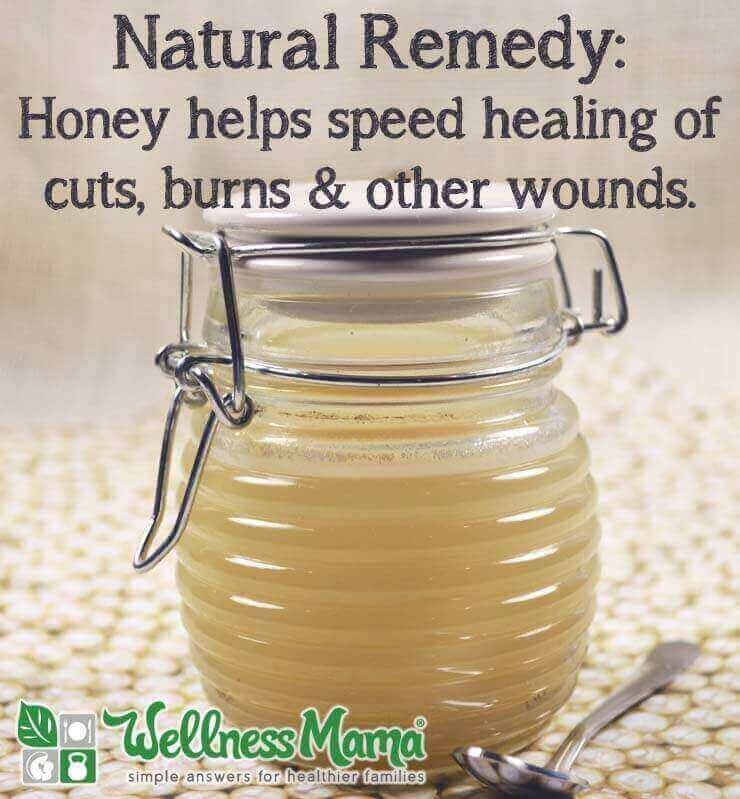I’m often amazed at things that our generation thinks we’ve discovered, only to find out that our grandmothers and great-grandmothers had been using them for years. An excellent example of this is using honey for healing wounds.
I’d seen some studies recently on using honey in hospitals for helping wounds and burns heal and I’d also known veterinarians who had used it on animals, so I started looking in to it more.
I also mentioned it to several people, and the ones old enough to remember more than a couple decades ago remembered using honey as a remedy. What’s old is new again, I suppose. I’d personally used honey internally for digestive problems and mixed with cinnamon during illnesses, but am glad to see all the research on topical ways to use it for healing wounds as well.
Research on Honey for Healing
Often, it seems that there is an unspoken divide between natural remedies and conventional medicine, but honey bridges this gap. There is a great deal of research supporting the use of certain types of honey in a medical setting, and it has been a natural remedy for centuries.
Research is even showing the ability of honey to help in cases of MRSA (methicillin resistant Staphylococcus aureus) and MSSA (methicillin sensitive Staphylococcus aureus), which are resistant to antibiotics.
This study explains:
“Honey works differently from antibiotics, which attack the bacteria’s cell wall or inhibit intracellular metabolic pathways. Honey is hygroscopic, meaning it draws moisture out of the environment and thus dehydrates bacteria. Its sugar content is also high enough to hinder the growth of microbes, but the sugar content alone is not the sole reason for honey’s antibacterial properties.
When honey is diluted with water, reducing its high sugar content, it still inhibits the growth of many different bacterial species that cause wound infections.
In addition to its antibacterial properties, medical honey hastens the healing of wounds through its anti-inflammatory effects. The amount of wound exudate is related to the activity of the local inflammatory process, in particular in wounds, which are colonized or infected with bacteria. Thus, the anti-inflammatory action of honey reduces oedema and the amount of exudate by down regulating the inflammatory process. It also reduces pain, as the pain in wounds results from the nerve endings being sensitized by prostaglandins produced in the process of inflammation, as well from the pressure on tissues resulting from oedema.”
Research has also shown the benefit of using certain types of honey when dressing burns. An especially compelling study showed that none of the nine most common organisms found in burn wounds could survive even a 30% concentration of raw honey. Another study showed that 28 of strains of bacteria that are most-resistant to antibiotics were all eliminated by raw honey.
Honey has been used in a medical setting for the following:
- As a salve on burns to reduce rates of infection and speed healing
- On amputee patients to speed recovery and reduce risk of complications
- In deep or puncture wounds- honey is used to fill the wound as it heals
- On bedsores
- On surgical wounds to speed healing
- On puncture wounds
- To fill abscesses after they have been drained to prevent complications
I know several midwives who recommend honey to patients to speed healing after a c-section.
My Personal Experience
My husband recently got a pretty severe cut on his foot. It had visibly cut through a vein and took a long time to stop bleeding. For several days after he cut it, it would re-open and bleed if he did too much activity.
I wish I’d remembered to try honey right away, but as soon as I remembered, I applied it to his foot. By the next morning, some of the redness was gone and after two days, it had closed up and was no longer bleeding if he moved around too much. I now also use raw manuka honey in place of antibiotic ointment for all cuts/burns at our house.
How to Use Honey for Healing
Regular raw honey can be used for healing, but a specific type has been shown to be most effective: Manuka Honey. It is made by bees after they pollinate the manuka (tea tree) flowers, giving it additional antibacterial properties.
It is important to only use raw (and preferably manuka) honey for wounds and burns. Regular honey found in most grocery stores has been heated and sometimes chemically altered, making it ineffective for wounds.
Regular raw/manuka honey can be used and I keep both of those on hand, but I also keep a specific medical-grade honey on hand since it has been verified to have a high concentration of manuka for additional antibacterial properties. I have the following three things at our house for burns and cuts:
- Medihoney Gel for burns and cuts
- Medihoney wound paste
- Medihoney wound dressings for big wounds
This article was medically reviewed by Dr. Lauren Jefferis, board certified in Internal Medicine and Pediatrics. As always, this is not personal medical advice and we recommend that you talk with your doctor or work with a doctor at SteadyMD.
Have you ever used honey as a natural remedy? How did you use it?





Leave a Reply